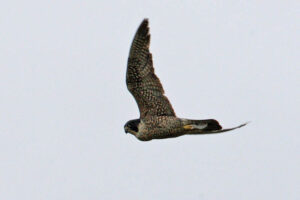Marine Biodiversity
Habitat: Sea Cliffs
Species: Peregrine Falcon
Scientific name: Falco peregrinus
Size: Up to 1.2m wingspan
Colour: dark grey upside with white underside and black bars across its chest
Distribution: Widespread resident in Ireland
The peregrine falcon is a bird of prey that is usually recognised when it is flying due to its spectacular hunting technique! The peregrine falcon will circle in the air and can spot its prey from above. Once the prey has been found, the falcon will ‘stoop’ down with its wings held close into the body, reaching great speeds. Estimates of speeds vary, but it seems likely that birds reach speeds more than 300km/hour, making it the fastest animal on the planet. The peregrine falcon kills its prey using the force of the impact of its legs at the last moment to inflict the killer blow. Prey includes pigeons, feral birds, thrushes, waders, wildfowl, gulls and seabirds.
The peregrine falcon has a heavy powerfully built body, medium length tail and wings which are broad close to the body and pointed at the tip. They have a short, hooked bill and females are larger in size than males. Adult birds are grey above, with a barred tail; the underparts are white. The throat and upper breast are plain white and in contrast to their black hood and thick head stripe. Juvenile birds are similar to adults but have brownish upperparts and streaked, not barred, feathers on the body.
Breeds on coastal and inland cliffs. Most birds on the coast breed on the south, west and north coasts, coastal breeding on the east coast is limited by the availability of suitable nesting cliffs. Most inland birds breed on mountain cliffs but will also breed at lower levels. The species is still recovering from a dramatic and well documented decline in the 1950s and 60s due to the effects of pesticide poisoning. The responsible pesticides have been banned and the species has been recovering slowly.
Resident in Ireland, but shows some movement away from its breeding areas in the winter. Can be found on the coast, especially on estuaries where they hunt on concentrations of water birds.

Image by David McNicholas

Image by MJ O Mahony
